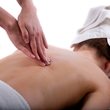
Massage therapy may be effective in reducing symptoms of carpal tunnel syndrome, according to a study.
Many forms of therapeutic superficial tissue manipulation have been practiced for thousands of years across cultures. Chinese use of massage dates to 1600 BC, and Hippocrates made reference to the importance of physicians being experienced with "rubbing" as early as 400 BC. There are references to massage in ancient records of the Chinese, Japanese, Arabic, Egyptian, Indian, Greek, and Roman nations. References to massage are also found in the Bible and the Vedas. Terms for massage include the French word masser, the Greek word for "knead," a Hindu word for "press," and an Aramaic word that means "to press softly." Many different therapeutic techniques can be classified as massage therapy. Most involve the application of fixed or moving pressure or manipulation of the muscles/connective tissues of clients. Practitioners may use their hands or other areas such as forearms, elbows, or feet. Lubricants may be added to aid the smoothness of massage strokes.
According to the American Physical Therapy Association, carpal tunnel syndrome affects more than five million Americans, especially those individuals performing repetitive movements for long periods of time. The carpal tunnel is a small passageway approximately the size of the thumb located on the palm side of the wrist. This tunnel protects a main nerve to the hand and nine tendons that bend the fingers. Carpal tunnel syndrome is caused by compression of the median nerve (nerve connected to the hand that controls some muscles that move the thumb). When pressure is placed on the median nerve, numbness and pain occur that eventually may lead to hand weakness. A combination of factors may contribute to carpal tunnel syndrome including trauma or injury to the wrist as well as various health conditions. However, with appropriate treatment, individuals may regain normal use of their hands.
In the current study, researchers investigated the use of massage therapy in the treatment of carpal tunnel syndrome. They recruited 21 people with the condition who received 30 minutes of massage therapy, twice weekly for a total of six weeks. The participants answered carpal tunnel symptom questionnaires, and the researchers used a series of assessments to determine the effectiveness of the technique.
The results showed that massage therapy had a significant effect on both symptom severity and functional status from two weeks.
The authors concluded that massage therapy may be a viable part of helping to treat symptoms of carpal tunnel syndrome.
Many integrative therapies have been studied for carpal tunnel syndrome relief. There is good scientific evidence supporting the use of yoga for this condition. Although acupuncture, physical therapy, and vitamin B6 have also been studied, there is conflicting evidence on their effectiveness.
For more information about massage therapy, please visit Natural Standard's Health & Wellness database.
The information in this brief report is intended for informational purposes only, and is meant to help users better understand health concerns. This information should not be interpreted as specific medical advice. Users should consult with a qualified healthcare provider for specific questions regarding therapies, diagnosis and/or health conditions, prior to making therapeutic decisions. Copyright © 2025 NatMed. Commercial distribution or reproduction prohibited. NatMed is the leading provider of high-quality, evidence-based, clinically-relevant information on natural medicine, dietary supplements, herbs, vitamins, minerals, functional foods, diets, complementary practices, CAM modalities, exercises and medical conditions. Monograph sections include interactions with herbs, drugs, foods and labs, contraindications, depletions, dosing, toxicology, adverse effects, pregnancy and lactation data, synonyms, safety and effectiveness.
